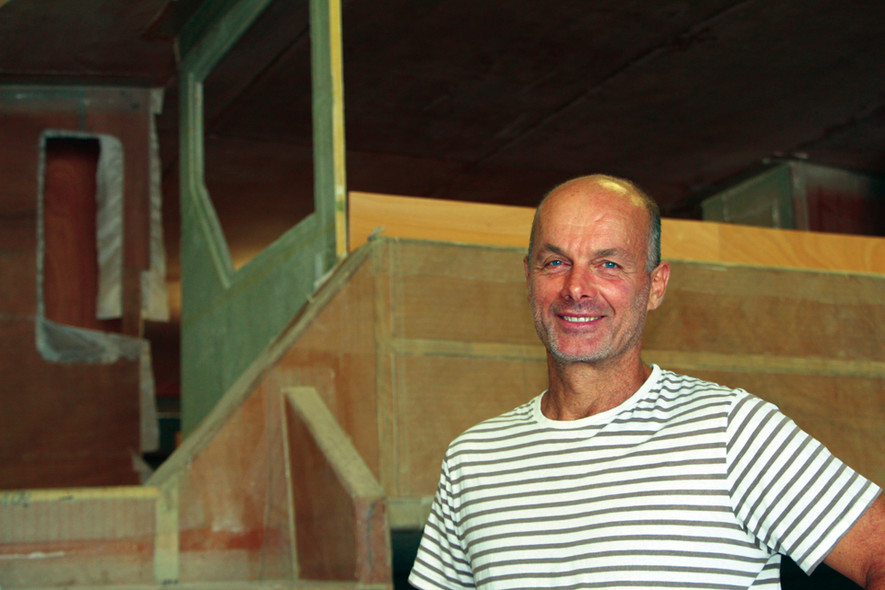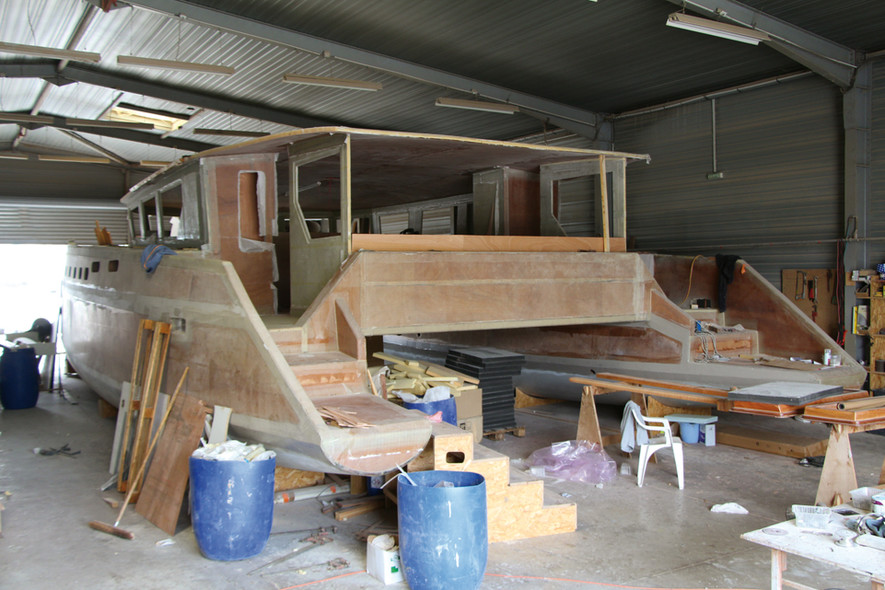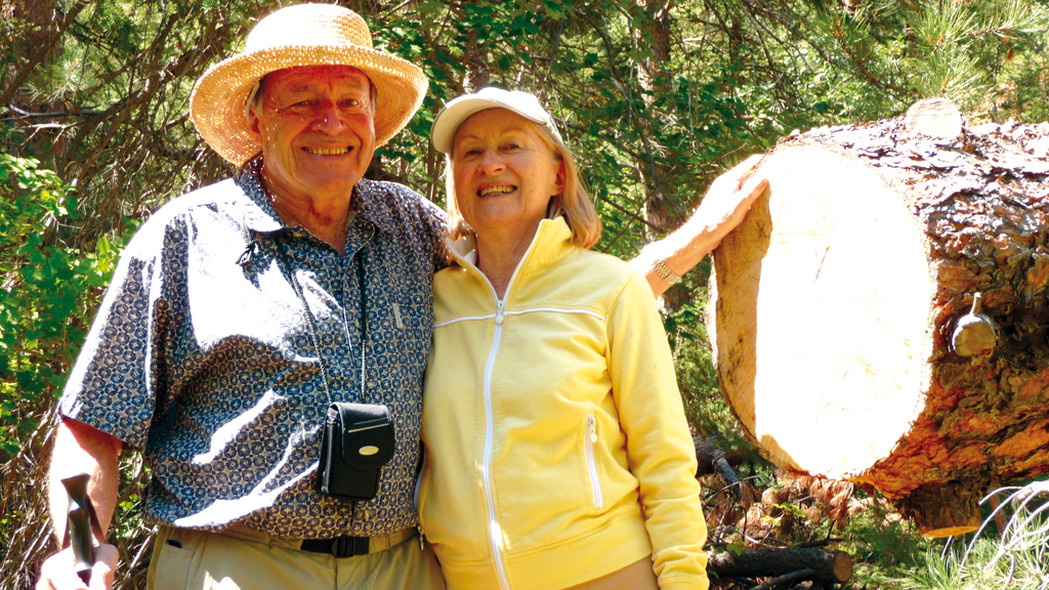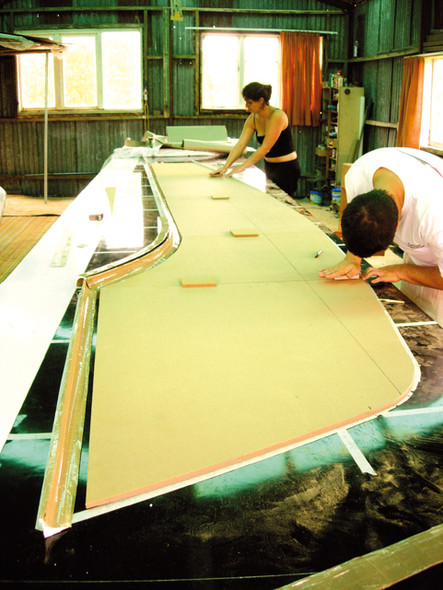
Issue #: 137
Published: September / October 2014
- Price per issue - digital : 5.40€Digital magazine
- Access to Multihulls World digital archives Digital archives
Multihull Mag Match is an open forum, a place where those in the multihull business can express their opinions. For this duel, we asked Derek Kelsall and Alain Borsotti to give us their views on the best way to build a catamaran. Wood/epoxy composite, or sandwich? We'll leave you to judge...
Alain Borsotti cut his teeth at the Méridienne shipyard, under Denis Kergomard, before going on to build the Etincelle 60' in Brazil (J. Fioleau), before finally settling in Sète where he created Rives Sud. Not just a multihull specialist but also a talented restorer and builder (Fleury Michon IV, Pat's) Alain is at home with all types of composites, but admits to a soft spot for wood/epoxy
"Over the last 25 years, building with wooden composites has been evolving continuously. When I built my first catamaran (a Philippe Harlé Punch 1000) it was like a two-footed Muscadet, with a plywood body sealed with resin, only laminated under the waterline and sealed using fillets. It is still sailing, in perfect condition, in the Caribbean. One other method was that of molded wood, a magical (yet very long!) way to build contoured multihulls which are light and very resistant. It took me four years to rebuild Fleury Michon 4, a 45' trimaran designed by Dick Newick! It's hard to justify this method these days because of the cost, which is a shame because it is the ultimate method.
The sheer range of different wood composite techniques means that it is possible to optimize the weight, mechanical constraints and all the demands relating to comfort and aesthetics, as long as the right material is used in the right place. The sail trawler RS57 which is currently under construction, is using the three main techniques that are employed today.
Strip planking, direct descendant of the molded wood method, is ideal for making the bottom of the hull. It is made up of strips of red cedar (a rotproof wood, in 20-30mm strips) stuck together and then covered with a biaxial fiberglass cloth impregnated with epoxy resin. This means that longitudinal tautness and shock resistance are guaranteed. The plywood comes into play for the bulkheads and planking. Digital cutting means that time can be saved and that there is a level of precision that would have been unthinkable even fifteen years ago.
Each individual element arrives pre-cut, according to the design, thanks to computer software which can be connected to a digital, industrial cutting machine. All of these elements are then pieced together on the floor like a giant puzzle. Using aligning pins and scarf joints allows for an optimum fixing of all the individual elements. Other elements are then added to the base of the hull, (transversals, bulkheads and other reinforcements) before everything is lined up using a laser. It required three people working for two weeks to line up the frame of the RS57. Before, the external sides of the planking were stratified under vacuum on marble, thus reducing the amount of finishing and sanding down needed. The interior is then impregnated with three coats of epoxy resin, meaning that even over a long time, humidity cannot penetrate.

For the bridge and the deckhouse, we think that the well-known technique derived from the sandwich is the most appropriate. For the RS57, we did the following: for the outer layer a sheet of fiberglass. The middle layer was a PVC mousse, and the inside layer was plywood. The plywood used as an interior facing, can be lacquered without too much tedious sanding and rendering work. The PVC foam ensures excellent thermic insulation, and the external stratification rounds off the general solidity of the build.
20 or 30 years ago, the assembling of all the different elements was done using only screws and fillets. It was sometimes their Achilles heel, allowing water seepage, as well as a certain structural weakness. These days, all the parts of a modern multihull are stratified using strips of cloth, which is usually biaxial. From the main partitions to the transversals and to the lowest levels, every part contributes to the overall structure. The result is there for all to see: a lightweight chassis with exceptional stiffness. By adding small quantities of carbon fiber at strategic points (mast bulkhead, beams, appendages) we can improve technical performance still further.
The progress in wood composite techniques over the last 30 years, coupled with all the different ways that they can be used, means that they represent an interesting alternative to other materials that are currently in use. The main criticisms that were made against wood a few decades ago have now been laid to rest. External maintenance has been made easier through the systematic use of cloth and epoxy resin as an outer coating on the whole of the boat. By using this system, the boat is well protected from humidity, and apart from a fresh coat of paint every 10 years, the upkeep is no more intensive than for any other material. The upkeep of the interior on the other hand, is much simpler: no vinyl liners, no patched-up units, but a uniform and smooth structure which makes for ease of cleaning and any renovation down the line. We are able to produce light yet resistant boats today thanks to this combination of materials such as biaxial fiberglass, carbon fiber, waterproof epoxy resin and relatively thin plywoods, which all come together to ensure an overall robustness. On top of all this, it is one of the most ecological materials used in nautical construction, as the proportion of wood used far exceeds that of oil-based products, meaning that the carbon footprint is much lower. Just one more argument which goes to show that wood composite is still today an important material in the world of boat construction."

Derek Kelsall is a multihull pioneer. Co-inventor of the sandwich process, he is also the designer of the famous THREE LEGS OF MANN for Nick Keig and of the first giant trimaran : WILLIAM SAURIN for Eugène Riguidel.
INTRODUCTION.
"I enjoyed working with wood. Adding resin at every step was less pleasant. For say, a canoe, strip timber can look amazing. However, if seeking efficiency in build time, cost and least weight, without compromising performance and taking the view that style should follow function, there is one technique which stands head and shoulders above any other. KSS foam sandwich.
PVC foam as a core between thin fiberglass skins is uniquely versatile. There is almost no limit to the ideas that can be applied. Ply is ply. Strip is strip, but the ways in which sheets of foam can be used is only limited by the imagination. I liken it to a computer program where there are regular updates.

WHY SANDWICH.
When I built my first trimaran in Texas, we used some rather poor plywood which was then covered by this wonderful material called fiberglass. Why, I asked is the fiberglass used only as a sheathing, when it looks so strong and durable. While knowing nothing about boat design or boat building at that time, I was enough of an engineer to realize that the prime requirement of most parts of a boat is panel stiffness and that some form of sandwich gives best stiffness. A sandwich structure consists of a lightweight core with thin, dense skins on each side. This is the equivalent of the “I” beam. The core resists relative movement between the skins. In this context, the stiffness is proportional to the square of the thickness. Double the core thickness and you have four times the stiffness but are adding only a relatively small amount of extra weight.
THE MATERIALS.
In 1965, I found the right materials in UK. It was during the time that fiberglass moulding was becoming popular so glass and resin were available. A company called BTR industries produced Pasticell, which is cross linked PVC foam, but had not previously been used for boats. Polyester resin was the most prevalent at the time and the one that I was familiar with. Today we often specify vinylester resin.
The traditional shaping is still applied today for the all compound curvature shapes applicable to most mono designs. Applying the outside skin, finishing the outside and then turning to apply the inside skin are tasks which are not particularly pleasant to do. Of course this applies to all alternatives except KSS. This approach gives a good structure, with the all important bond between core and skin assured by applying wet resin direct to the foam core. Most builders look for a fine finish. This means applying layers of filler and sanding each layer. Both are skilled jobs. The skins of many multis are only one or two mm thick. I have found filler up to ten or twelve mm thick . The filler can easily double the skin weight. In 1973, the table changed everything. The quality, the time, the atmosphere in the workshop and the enthusiasm of the boat builders all improved dramatically. As we were making full size panels, which could be bent to a gentle curve, fair lines where guaranteed. As we worked but also designed, I was always on the look out for ways of moving any part off the boat onto the table. Eventually the time came when every part of the structure started life on the table. Vacuum was used to ensure the bond between the skin and the core. Heat could be applied both above and below the table to ensure a quality resin cure. KSS (Kelsall Swiftsure Sandwich) is the term, suggested by our first owner build client, that we adopted in 1990.
Clients quickly took to KSS. No other technique could produce fair, lightweight hulls in the 3-4 days which our clients and our team did regularly.

THE VERSATILITY OF FOAM.
Foam as a core has some remarkable properties. I liken it to an extremely lightweight timber, where there is no grain direction. In some applications we utilize the elasticity of the foam to assist in shaping.
OTHER TASKS ON THE MOULD TABLE.
We quickly realized that there are lots of tasks which can be done on the table while making the panels, particularly edge treatment. A batten laid at the edge of the panel, for instance, produced the deck edge radius. This all important curve is guaranteed to give a fair deck edge provided it looks fair on the table. Other tasks done on the table include preparation for bolting, capping of openings, bringing both skins together, recesses for joining, windows and hatches.
The stiffness of panels can be adjusted to eliminate the need for internal or external stiffeners. The stresses on hulls vary along the length of the hull and similarly for other parts. Both the foam thickness and the scanglings can vary to suit, saving weight and cost. Resin infusion became open technology 14 years ago. While it requires considerable experience and skill to apply in moulds, it is straightforward on the table and learned in a few days of test panels and smaller panels. The advantages are excellent laminating results, a clean workshop and the ability to produce the full sandwich in one shot. Previously, the second skin was done as a separate operation. I will mention that we do have what we call a non-resin infusion panel making method, which is applicable to smaller boats or for single panels.
SUMMARY - KSS for-
Least weight.
Least build time.
Best laminates
Fair lines.
Cleanest workshop.
Least onerous finishing.
Modular assembly.
Most durable - 45 yo Kelsalls are passing structural survey with flying colors.
Easy to repair.
It is the most satisfying way to build.
The only down side; KSS cannot be applied to the all-compound curve style which is popular with some designers, though it is always possible to combine the original foam technique with work on the KSS table.
What readers think
Post a comment
No comments to show.